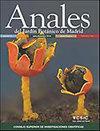秘鲁干旱区黏菌的多样性第二部分:仙人掌带和过渡带
IF 0.7
4区 生物学
Q4 PLANT SCIENCES
引用次数: 6
摘要
报告了秘鲁干旱地区黏菌的第二次调查结果。在6年多的时间里,在海拔1500米至3000米之间的仙人掌带(“枢机区”)共采集了37个地点的样本。这项调查是基于601个可识别的黏菌集合,在自然条件下在野外开发或从湿室培养中恢复。共记录到19属84个分类群。报告了1个新种,Cribraria spinispora Lado & d.r igley sp. nov., 3个南美新种,秘鲁新种22个。特有植物,特别是仙人掌,作为黏菌基质具有特殊的相关性。Physarales T.Macbr目的优势性。在干旱地区是加强。评论包括对一些收藏品,以及几个物种的扫描电镜显微照片。还包括对该地区黏菌多样性的统计评估,并将该地区与秘鲁沿海干燥沙漠和其他新热带干旱环境进行比较。结果表明,干旱区黏菌丰富,且各地区黏菌组合独特。这种差异似乎与寄主植物有关。本文章由计算机程序翻译,如有差异,请以英文原文为准。
Diversity of Myxomycetes in arid zones of Peru part II: the cactus belt and transition zones
The results obtained from a second survey for Myxomycetes in the arid areas of Peru are reported. A total of 37 localities from the cactus belt (‘cardonal’), between 1500 and 3000 m a.s.l., were sampled over six years. This survey is based on 601 identifiable collections of myxomycetes, developed in the field under natural conditions or those that were recovered from moist chamber cultures. In total, 84 taxa representing 19 genera were recorded. One new species, Cribraria spinispora Lado & D.Wrigley sp. nov., is described, three species new to South America and 22 additional new species for Peru are reported as well. Endemic plants, expecially cacti, had a particular relevance as myxomycete substrates. The predominance of the order Physarales T.Macbr. in arid areas is reinforced. Comments are included on some collections, as well as SEM micrographs of several species. A statistical evaluation of the diversity of myxomycetes in the cardonal area and a comparison of this area with the dry coastal desert of Peru and other Neotropical xeric environments are also included. Results show that the arid areas are rich in myxomycetes, and that each area has a unique assemblage. The differences appear to be related to the host plants.
求助全文
通过发布文献求助,成功后即可免费获取论文全文。
去求助
来源期刊

Anales Del Jardin Botanico De Madrid
PLANT SCIENCES-
CiteScore
1.20
自引率
0.00%
发文量
9
审稿时长
>12 weeks
期刊介绍:
Anales del Jardín Botánico de Madrid features original and unpublished articles in fields such as taxonomy and systematics of all plant groups and fungi, including related fields like biogeography, bioinformatics, conservation, ecophysiology, phylogeny, phylogeography, functional morphology, nomenclature and plant-animal relations, as well as reviews and summary works. Anales del Jardín Botánico de Madrid is published half-yearly, with two issues appearing in June and December.
 求助内容:
求助内容: 应助结果提醒方式:
应助结果提醒方式:


